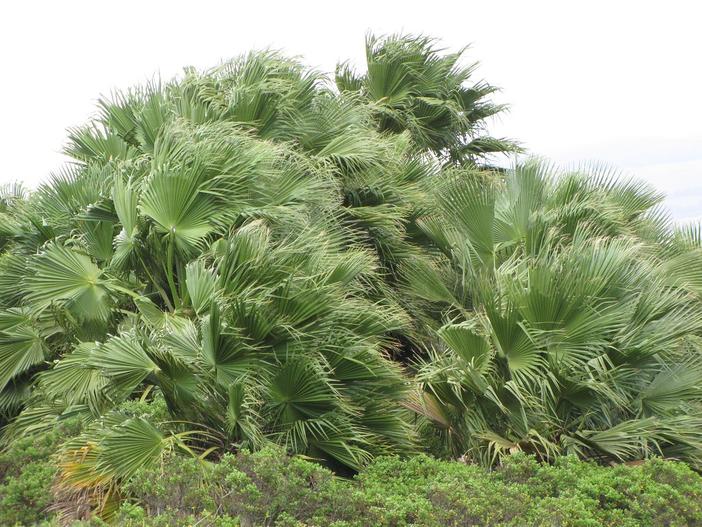Mexican Fan Palm
(Washingtonia robusta)
Mexican Fan Palm (Washingtonia robusta)
/
/

Forest and Kim Starr
CC BY 2.0
Image By:
Forest and Kim Starr
Recorded By:
Copyright:
CC BY 2.0
Copyright Notice:
Photo by: Forest and Kim Starr | License Type: CC BY 2.0 | License URL: https://creativecommons.org/licenses/by/2.0/ | Uploader: Starr Environmental | Publisher: Flickr





































































































Estimated Native Range
Summary
Washingtonia robusta, commonly known as Mexican Fan Palm, is an evergreen tree native to desert oases in Baja California and Sonora in Mexico. It is often found in riparian areas within deserts, where it can access underground water. This palm can grow to a height of 25 meters (82 feet), and occasionally reaches up to 30 meters (98 feet). It has a slender, columnar trunk and a crown of large, fan-shaped fronds. The inflorescence extends up to 3 meters (10 feet) and bears numerous small, pale orange-pink flowers. Flowering occurs in late spring to early summer. The fruit is a spherical, blue-black drupe, 6–8 mm in diameter, and is edible but not commonly consumed due to its thin flesh.
Mexican Fan Palm is valued for its rapid growth and tropical appearance, making it a popular choice for urban landscaping, avenue plantings, and as a focal point in gardens. It thrives in full sun and requires high amounts of water, especially in well-draining soils. While it is drought-tolerant once established, regular watering promotes optimal growth. This species is known for its tolerance of poor soils and urban pollution. However, it can become invasive outside its native range, particularly in regions like California and Florida, where it can outcompete native vegetation. Gardeners should be cautious and check local regulations before planting.CC BY-SA 4.0
Mexican Fan Palm is valued for its rapid growth and tropical appearance, making it a popular choice for urban landscaping, avenue plantings, and as a focal point in gardens. It thrives in full sun and requires high amounts of water, especially in well-draining soils. While it is drought-tolerant once established, regular watering promotes optimal growth. This species is known for its tolerance of poor soils and urban pollution. However, it can become invasive outside its native range, particularly in regions like California and Florida, where it can outcompete native vegetation. Gardeners should be cautious and check local regulations before planting.CC BY-SA 4.0
Plant Description
- Plant Type: Trees
- Height: 82-98 feet
- Width: 10-15 feet
- Growth Rate: Rapid
- Flower Color: White
- Flowering Season: Summer
- Leaf Retention: Evergreen
Growth Requirements
- Sun: Full Sun
- Water: High
- Drainage: Fast, Medium
Common Uses
Bee Garden, Bird Garden, Deer Resistant, Drought Tolerant, Low Maintenance, Salt Tolerant
Natural Habitat
Desert oases in Baja California and Sonora
Other Names
Common Names: Mexican Washingtonia , Skyduster , Thread Palm , Mexikanische Washingtonpalme , Palmier Évantail Du Mexique , Robustapalm
Scientific Names: Washingtonia robusta , Washingtonia sonorae , Washingtonia gracilis , Washingtonia filifera var. robusta , Brahea robusta , Neowashingtonia robusta , Neowashingtonia sonorae , Pritchardia robusta , Washingtonia filifera var. gracilis , Washingtonia filifera var. sonorae , Washingtonia robusta var. gracilis
GBIF Accepted Name: Washingtonia robusta H.Wendl.